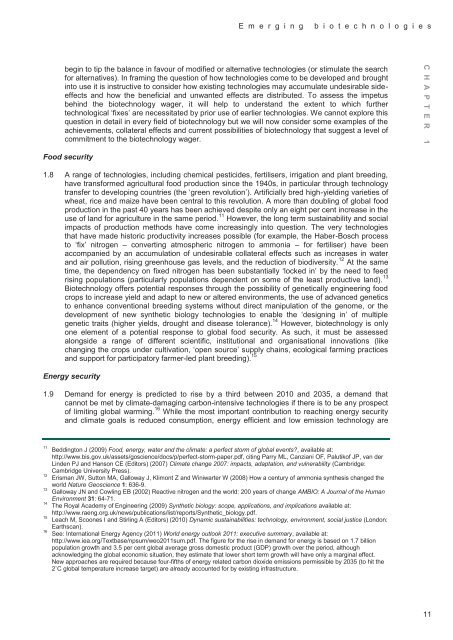Emerging biotechnologies: full report - Nuffield Council on Bioethics
Emerging biotechnologies: full report - Nuffield Council on Bioethics
Emerging biotechnologies: full report - Nuffield Council on Bioethics
Create successful ePaper yourself
Turn your PDF publications into a flip-book with our unique Google optimized e-Paper software.
E m e r g i n g b i o t e c h n o l o g i e s<br />
begin to tip the balance in favour of modified or alternative technologies (or stimulate the search<br />
for alternatives). In framing the questi<strong>on</strong> of how technologies come to be developed and brought<br />
into use it is instructive to c<strong>on</strong>sider how existing technologies may accumulate undesirable sideeffects<br />
and how the beneficial and unwanted effects are distributed. To assess the impetus<br />
behind the biotechnology wager, it will help to understand the extent to which further<br />
technological ‘fixes’ are necessitated by prior use of earlier technologies. We cannot explore this<br />
questi<strong>on</strong> in detail in every field of biotechnology but we will now c<strong>on</strong>sider some examples of the<br />
achievements, collateral effects and current possibilities of biotechnology that suggest a level of<br />
commitment to the biotechnology wager.<br />
C H A P T E R 1<br />
Food security<br />
1.8 A range of technologies, including chemical pesticides, fertilisers, irrigati<strong>on</strong> and plant breeding,<br />
have transformed agricultural food producti<strong>on</strong> since the 1940s, in particular through technology<br />
transfer to developing countries (the ‘green revoluti<strong>on</strong>’). Artificially bred high-yielding varieties of<br />
wheat, rice and maize have been central to this revoluti<strong>on</strong>. A more than doubling of global food<br />
producti<strong>on</strong> in the past 40 years has been achieved despite <strong>on</strong>ly an eight per cent increase in the<br />
use of land for agriculture in the same period. 11 However, the l<strong>on</strong>g term sustainability and social<br />
impacts of producti<strong>on</strong> methods have come increasingly into questi<strong>on</strong>. The very technologies<br />
that have made historic productivity increases possible (for example, the Haber-Bosch process<br />
to ‘fix’ nitrogen – c<strong>on</strong>verting atmospheric nitrogen to amm<strong>on</strong>ia – for fertiliser) have been<br />
accompanied by an accumulati<strong>on</strong> of undesirable collateral effects such as increases in water<br />
and air polluti<strong>on</strong>, rising greenhouse gas levels, and the reducti<strong>on</strong> of biodiversity. 12 At the same<br />
time, the dependency <strong>on</strong> fixed nitrogen has been substantially ‘locked in’ by the need to feed<br />
rising populati<strong>on</strong>s (particularly populati<strong>on</strong>s dependent <strong>on</strong> some of the least productive land). 13<br />
Biotechnology offers potential resp<strong>on</strong>ses through the possibility of genetically engineering food<br />
crops to increase yield and adapt to new or altered envir<strong>on</strong>ments, the use of advanced genetics<br />
to enhance c<strong>on</strong>venti<strong>on</strong>al breeding systems without direct manipulati<strong>on</strong> of the genome, or the<br />
development of new synthetic biology technologies to enable the ‘designing in’ of multiple<br />
genetic traits (higher yields, drought and disease tolerance). 14 However, biotechnology is <strong>on</strong>ly<br />
<strong>on</strong>e element of a potential resp<strong>on</strong>se to global food security. As such, it must be assessed<br />
al<strong>on</strong>gside a range of different scientific, instituti<strong>on</strong>al and organisati<strong>on</strong>al innovati<strong>on</strong>s (like<br />
changing the crops under cultivati<strong>on</strong>, ‘open source’ supply chains, ecological farming practices<br />
and support for participatory farmer-led plant breeding). 15<br />
Energy security<br />
1.9 Demand for energy is predicted to rise by a third between 2010 and 2035, a demand that<br />
cannot be met by climate-damaging carb<strong>on</strong>-intensive technologies if there is to be any prospect<br />
of limiting global warming. 16 While the most important c<strong>on</strong>tributi<strong>on</strong> to reaching energy security<br />
and climate goals is reduced c<strong>on</strong>sumpti<strong>on</strong>, energy efficient and low emissi<strong>on</strong> technology are<br />
11<br />
12<br />
13<br />
14<br />
15<br />
16<br />
Beddingt<strong>on</strong> J (2009) Food, energy, water and the climate: a perfect storm of global events?, available at:<br />
http://www.bis.gov.uk/assets/goscience/docs/p/perfect-storm-paper.pdf, citing Parry ML, Canziani OF, Palutikof JP, van der<br />
Linden PJ and Hans<strong>on</strong> CE (Editors) (2007) Climate change 2007: impacts, adaptati<strong>on</strong>, and vulnerability (Cambridge:<br />
Cambridge University Press).<br />
Erisman JW, Sutt<strong>on</strong> MA, Galloway J, Klim<strong>on</strong>t Z and Winiwarter W (2008) How a century of amm<strong>on</strong>ia synthesis changed the<br />
world Nature Geoscience 1: 636-9.<br />
Galloway JN and Cowling EB (2002) Reactive nitrogen and the world: 200 years of change AMBIO: A Journal of the Human<br />
Envir<strong>on</strong>ment 31: 64-71.<br />
The Royal Academy of Engineering (2009) Synthetic biology: scope, applicati<strong>on</strong>s, and implicati<strong>on</strong>s available at:<br />
http://www.raeng.org.uk/news/publicati<strong>on</strong>s/list/<str<strong>on</strong>g>report</str<strong>on</strong>g>s/Synthetic_biology.pdf.<br />
Leach M, Sco<strong>on</strong>es I and Stirling A (Editors) (2010) Dynamic sustainabilities: technology, envir<strong>on</strong>ment, social justice (L<strong>on</strong>d<strong>on</strong>:<br />
Earthscan).<br />
See: Internati<strong>on</strong>al Energy Agency (2011) World energy outlook 2011: executive summary, available at:<br />
http://www.iea.org/Textbase/npsum/weo2011sum.pdf. The figure for the rise in demand for energy is based <strong>on</strong> 1.7 billi<strong>on</strong><br />
populati<strong>on</strong> growth and 3.5 per cent global average gross domestic product (GDP) growth over the period, although<br />
acknowledging the global ec<strong>on</strong>omic situati<strong>on</strong>, they estimate that lower short term growth will have <strong>on</strong>ly a marginal effect.<br />
New approaches are required because four-fifths of energy related carb<strong>on</strong> dioxide emissi<strong>on</strong>s permissible by 2035 (to hit the<br />
2˚C global temperature increase target) are already accounted for by existing infrastructure.<br />
11
















